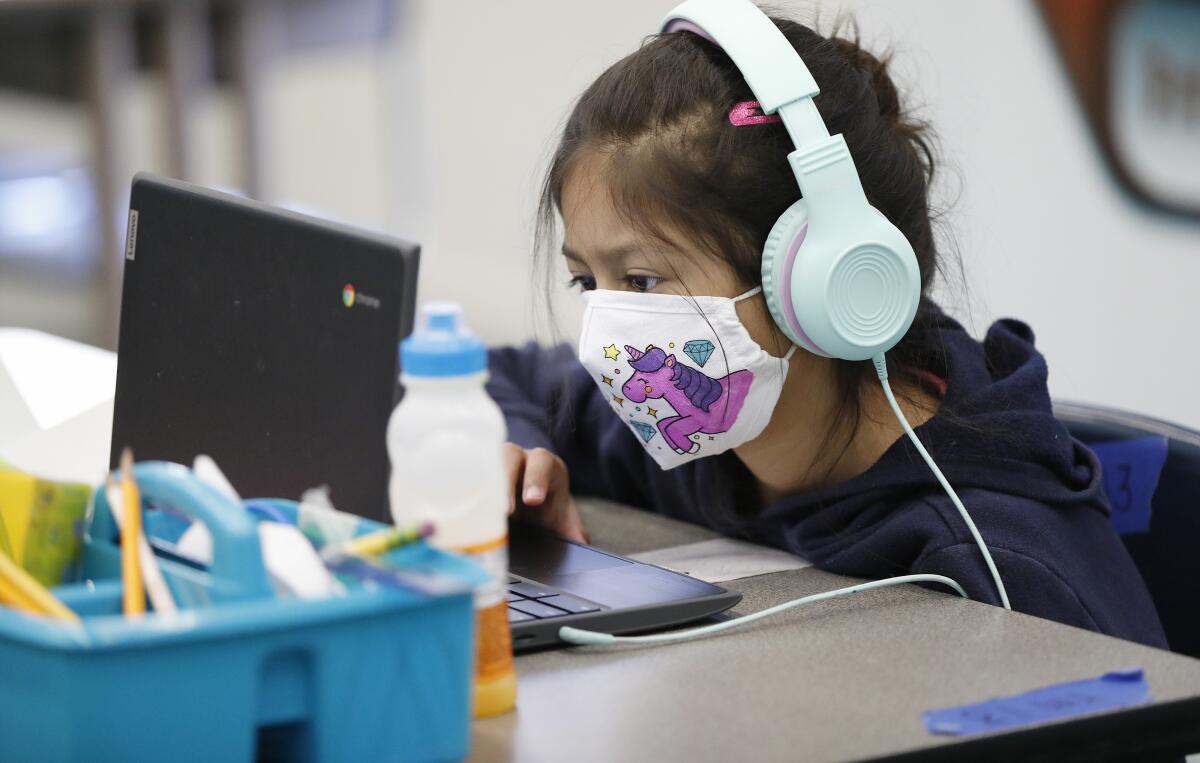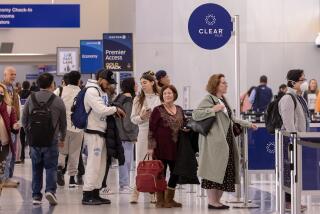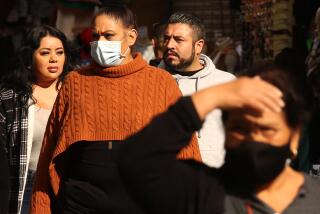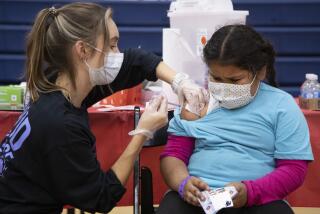In abrupt turnaround, California to let school districts decide how to enforce mask rules

- Share via
The complications of managing COVID-era education took a dramatic turn Monday, when state officials issued a rule barring unmasked students from campuses, and then, hours later, rescinded that rule — while keeping in place a mask mandate for all at K-12 schools.
Instead, the latest revision allows local school officials to decide how to deal with students who refuse to wear masks, a spokesman for Gov. Gavin Newsom said Monday night.
The statewide policy that prohibited unmasked students from campus had been intended to provide helpful clarity for local educators as they work to provide a safe environment for staff and students.
The original language, which became official at 3 p.m., stated, “Schools must exclude students from campus if they are not exempt from wearing a face covering under California Dept. of Public Health guidelines and refuse to wear one provided by the school.”
In addition, the guidance stated that “schools should offer alternative educational opportunities for students who are excluded from campus because they will not wear a face covering.”
But the rule was almost immediately reconsidered.
At 7:25 p.m., the California Department of Public Health tweeted out a change of direction: “California’s school guidance will be clarified regarding masking enforcement, recognizing local schools’ experience in keeping students and educators safe while ensuring schools fully reopen for in-person instruction.”
A spokesman for the governor’s office then confirmed that the phrasing about excluding students would be dropped. Instead, local officials would have discretion about how to enforce the mask mandate, just as they had during the school year just concluded, said Alex Stack.
Even with mask enforcement left to schools, the state’s COVID-19 safeguards rank among the most stringent in the nation. California health and education officials are acutely concerned with cases of the Delta variant on the rise as the new academic year approaches.
Newsom and state public health Director Mark Ghaly have emphasized that the state is operating within guidelines released Friday by the U.S. Centers for Disease Control and Prevention, which provide schools ample flexibility and prioritize the full reopening of campuses. Under the CDC guidelines, for instance, school officials could choose not to require masks for vaccinated students. Unvaccinated students, however, should be masked and separated by at least three feet — part of multiple layers of available safety measures, including good ventilation, campus sanitizing and frequent handwashing.
The digital platform Burbio, which earlier tracked school reopenings, has added a tracker on mask mandates. California is one of nine states it lists as requiring masks. Others include Washington, New Mexico, North Carolina and New York.
Some states have defined their own rules outside of CDC guidance. Arizona lawmakers have prohibited masks requirements in schools, which some public health experts have decried as foolhardy, with more contagious and possibly more virulent COVID variants on the rise. Others among the eight states that ban mask mandates include Texas, Arizona, Vermont and South Carolina, according to Burbio.
Three states — Illinois, Michigan and West Virginia — make mask-wearing contingent on vaccination status. Other states offer varying degrees of local flexibility.
Only children 12 and older are currently eligible to be vaccinated, but many, although eligible, have not been inoculated.
Requiring masks “seems to be a safe course for ensuring that every student can come back to school in the fall,” said state Supt. of Public Instruction Tony Thurmond, who has reviewed the state health rules. “I certainly see the logic of it.”
For the most part, the rules released Monday expand on what state officials indicated Friday — that masks would continue to be required even as other aspects of schooling, such as the length of the school day, returned to normal.
Some parents said the new rules were overcautious and counterproductive.
“There are 50k maskless Dodger fans drinking, eating and shouting: no testing, masking, screening or vaccination mandate. But schools aren’t safe?” said Christie Pesicka, an elementary school parent in Los Angeles and a leader of the local parents group California Students United. “Maybe if we rename school: church, band, concert, play structure, amusement park... sporting event? The hypocrisy is mind-blowing!”
But the mask mandate could prove reassuring to many parents, said Katie Braude, chief executive of the local advocacy group Speak Up.
“Given the hesitancy of many families to send their kids back to school, especially in low-income communities of color, masks remain an important safety measure for now,” Braude said. “This is especially true as the Delta variant spreads, and cases start to increase again in Los Angeles, which prompted the Health Department to urge fully vaccinated people to wear masks indoors.”
Ilan Shapiro, a fellow at the American Academy of Pediatrics, which called for schools to reopen more quickly, said the state guidelines, including the mask mandate, align with the organization’s recommendations.
“It’s a good time to reflect on how we can protect our kids” as well as school community members, Shapiro said, “It’s the teacher that has diabetes, the administrative people doing day-to-day work. There’s a lot of other people around schools. It’s not just kids, per se. It’s the community around.”
Students may not be sent home if they forget a mask or lose a mask. Schools must provide masks as needed. Staff also must wear masks when in contact with students, regardless of vaccination status.
The state and the CDC also want to limit potential disruptions caused by overaggressive quarantine policies. They have updated rules to limit when and how long students must remain isolated from classmates.
For example, when an infected student and an unvaccinated close contact are both wearing masks, the contact may continue to attend school if that student is asymptomatic, continues to mask and undergoes at least twice-weekly testing during a 10-day period.
A close contact would be a person exposed to an infected masked individual for more than 15 minutes over a 24-hour period within 6 feet indoors.
More to Read
Sign up for Essential California
The most important California stories and recommendations in your inbox every morning.
You may occasionally receive promotional content from the Los Angeles Times.












